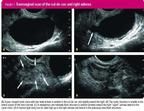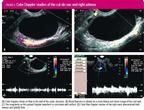U/S: Gynecologic emergency: torsion of the right fallopian tube in pregnancy
Acute pelvic pain early in pregnancy can be linked to a number of conditions, including appendicitis and urolithiasis. When the cause is torsion, saving the organ requires immediate and accurate treatment.
ULTRASOUND CLINICS
Gynecologic emergency:
torsion of the right fallopian tube in pregnancy
By Ana Monteagudo, MD, Rebecca Margulies, MD, and Robert Berg, MD
Acute pelvic pain early in pregnancy can be linked to a number of conditions, including appendicitis and urolithiasis. When the cause is torsion, saving the organ requires immediate and accurate treatment.
During the first and early second trimesters of pregnancy, the differential diagnosis of acute pelvic pain typically includes torsion of an ovary or of an adnexal mass, appendicitis, urolithiasis, degenerating myomas, or infrequently a heterotopic pregnancy. Rarely is tubal torsion included in the differential diagnosis. Torsion of both the ovary and tube or either organ separately constitutes a gynecologic emergency. Accurate and immediate diagnosis that leads to swift and relatively easy surgery may save the organ and should immediately relieve the patient's symptoms. We present a case of isolated tubal torsion diagnosed by ultrasound in the 12th week of pregnancy.
Case presentation
The patient, L.S., was a 30-year-old G1, P0 at 11 3/7 weeks' gestation by last menstrual period. She presented to our emergency department with worsening, intermittent right-lower-quadrant pain for the last 3 days. L.S. also complained of nausea and vomiting but denied any fever, chills, cramping, or vaginal bleeding.
The patient's antenatal history was significant for a similar episode of right-lower-quadrant pain at 8 weeks that subsequently resolved. At that time, transvaginal U/S confirmed a viable intrauterine pregnancy and revealed a 5.5 x 4.8 x 3.9-cm well-defined smooth, thin-walled, sonolucent cyst in the right adnexa. Doppler studies done during the 8-week scan revealed normal flow velocities and resistive indices. L.S.'s past medical, surgical, and gynecologic histories were otherwise unremarkable.
On physical exam, the patient was slender and in moderate distress. Her vital signs were within normal limits, except for a heart rate of 119 beats per minute. Physical exam was significant for abdominal tenderness to deep palpation in the right lower quadrant. L.S. had no rebound or guarding, her abdomen was soft and nondistended, and her bowel sounds were normal.
Transvaginal sonography revealed a viable intrauterine pregnancy with positive fetal movement and cardiac activity, with a crown-rump length consistent with 12 weeks. The patient's left ovary appeared normal. In the cul-de-sac, slightly toward the right adnexa, a cystic pear-shaped structure was identified that measured 6.8 x 4.1 x 5.1 cm and contained low-level echoes (Figure 1). Evaluation with color Doppler showed that the structure had minimal blood flow (Figure 2A-C). Lateral to the mass, a serpiginous tubular structure was visible (Figure 1C). Further evaluation of the right adnexa, higher up in the right side, showed a normal-appearing right ovary with normal Doppler flow (Figures 1 and 2D). Given the sonographic findings, the differential diagnosis included torsion of the right fallopian tube rather than torsion of a para-tubal cyst.


We then took L.S. to the operating room for a pelvic examination under epidural anesthesia. This procedure revealed a 12-week size uterus with a 6-cm mobile mass in the cul-de-sac. The patient underwent exploratory laparotomy through a Pfannenstiel incision. Intraoperative findings included a normal-appearing 12-week-size uterus, ovaries, and left fallopian tube. The right fallopian tube, however, was dilated to approximately 6 cm, necrotic, purple, and twisted five times upon itself. The fimbriae were distorted but still identifiable at the distal end. The tube was filled with dark, hemorrhagic fluid, but the portion proximal to the torsion looked pink and healthy (Figure 3). There was no visible paratubal cyst. L.S. tolerated an uncomplicated right salpingectomy well and fetal viability was confirmed in the immediate postoperative period. After discharge the next day, she did well.

The patient's pathology specimen was grossly described as a 7 x 6 x 5-cm ovoid cystic lesion filled with dark blood and clots that weighed 70 g. The internal surface was hemorrhagic with attached blood clots. The average wall thickness of L.S.'s tube was 2 to 3 mm. The final pathology was read as attenuated cyst wall lacking a normal epithelial lining, filled with blood clot. No normal fallopian tube tissue was seen.
Implications for clinical practice
When "normal" adnexae are imaged on U/S, the ovaries usually can be seen. The normal fallopian tube, however, rarely is visible because it is so slender and thin, with tortuous anatomy. Occasionally a fallopian tube can be seen if it is surrounded by fluid. When the structure is visible on U/S, it most likely is abnormal. Pathological processes involving the tube include: (1) thickening and edema associated with acute salpingitis with scant intraluminal fluid; (2) dilation and fluid in a thin-walled tube, as seen in chronic hydrosalpinx; (3) dilation by blood clots or a well-defined tubal ring because of a tubal ectopic pregnancy; or (4) a tube surrounded by the wall of a mass, as in tubal carcinoma.1
Over the last 40 years, several case reports of torsion of a fallopian tube have appeared in the literature.2-17 Isolated fallopian tube torsion is relatively rare and even more unusual in combination with pregnancy. Reportedly only about 12% of cases of isolated fallopian tube torsion occur in pregnancy.2
The accurate diagnosis of selective torsion of the fallopian tube relies upon both clinical and sonographic findings. Clinically, a patient will present with acute (usually unilateral) pelvic pain, with classical signs of rebound and cervical motion tenderness on bimanual pelvic exam. Right-sided fallopian tube torsion has been described more often than left-sided because the symptoms are very similar to those of acute appendicitis, which usually requires rapid surgical treatment.6,18
The sonographic features of tubal torsion include tubal thickening, hematosalpinx, and adnexal mass with a wide range of echogenicities.6,11 In L.S.'s case, the sonographic image was slightly different than that previously reported, since her fallopian tube was thin-walled, but the adnexa had a cystic structure and contained low-level echoes (hematosalpinx). Further "fine tuning" of the diagnosis can be achieved by using color Doppler.19,20 In cases of suspected adnexal torsion, it's usually difficult to interpret arterial and venous blood flow results using color Doppler. Absence of flow, however, suggests a nonviable ovary.20 It may or may not be possible to elicit blood flow signals from the thin wall of a twisted fallopian tube, but one must clearly demonstrate blood flow in the adjacent normal ovary. Previous reports in the literature have not clearly described that a normal ovary must be seen on the side of the fallopian tube torsion. This is the most important sonographic marker for this disorder and essentially rules out ovarian torsion as the cause of a patient's pelvic pain.
REFERENCES
1. Timor-Tritsch I, Lerner JP, Monteagudo A, et al. Transvaginal sonographic markers of tubal inflammatory disease. Ultrasound Obstet Gynecol. 1998;12:56-66.
2. Isager-Sally L, Weber T. Torsion of the fallopian tube during pregnancy. Acta Obstet Gynecol Scand. 1985;64:349-351.
3. Sharma B, Preston J, Greenwood P, et al. Isolated torsion of the fallopian tube: two case reports. J Obstet Gynaecol. 2003;23:329-330.
4. Krissi H, Shalev J, Bar-Hava I, et al. Fallopian tube torsion: laparoscopic evaluation and treatment of a rare gynecological entity. J Am Board Fam Pract. 2001;14:274-277.
5. Onuma O, Matthews G. Isolated torsion of the fallopian tube. Aust N Z J Obstet Gynaecol. 2000;40:213-214.
6. Richard HM 3rd, Parsons RB, Broadman KF, et al. Torsion of the fallopian tube: progression of sonographic features. J Clin Ultrasound. 1998;26:374-376.
7. Propeck PA, Scanlan KA. Isolated fallopian tube torsion. Am J Roentgenol. 1998;170:1112-1113.
8. Milki A, Jacobson DH. Isolated torsion of the fallopian tube. A case report. J Reprod Med. 1998;43:836-838.
9. Yalcin OT, Hassa H, Zeytinoglu S, et al. Isolated torsion of fallopian tube during pregnancy; report of two cases. Eur J Obstet Gynecol Reprod Biol. 1997;74:179-182.
10. Ferrera PC, Kass LE, Verdile VP. Torsion of the fallopian tube. Am J Emerg Med. 1995;13:312-314.
11. Elchalal U, Caspi B, Schachter M, et al. Isolated tubal torsion: clinical and ultrasonographic correlation. J Ultrasound Med. 1993;12:115-117.
12. Mckenna PJ, Gerbert KH. Isolated torsion of the uterine tube in pregnancy. A case report. J Reprod Med. 1989;34:187-188.
13. Dueholm M, Praest J. Isolated torsion of the normal fallopian tube. Acta Obstet Gynecol Scand. 1987;66:89-90.
14. Kumar EB, Codrington-Meggs GC, Rao AB, et al. Isolated torsion of the Fallopian tube. West Indian Med J. 1984;33:120-122.
15. Bernardus RE, Van Der Slikke JW, Roex AJ, et al. Torsion of the fallopian tube: some considerations on its etiology. Obstet Gynecol. 1984;64:675-678.
16. Filtenborg TA, Hertz JB. Torsion of the fallopian tube. Eur J Obstet Gynecol Reprod Biol. 1981;12:177-181.
17. Sherer DM, Liberto L, Abramowicz JS, et al. Endovaginal sonographic features associated with isolated torsion of the fallopian tube. J Ultrasound Med. 1991;10:107-109.
18. Blair CR. Torsion of the fallopian tube. Surg Gynecol Obstet. 1962;114:727-730.
19. Baumgartel PB, Fleischer Ac, Cullinan JA, et al. Color Doppler sonography of tubal torsion. Ultrasound Obstet Gynecol. 1996;7:367-370.
20. Fleischer AC, Stein SM, Cullinan JA, et al. Color Doppler sonography of adnexal torsion. J Ultrasound Med. 1995;14:523-528.
DR. MONTEAGUDO is Professor of Obstetrics and Gynecology and Associate Director of the New York University School of Medicine Obstetrical and Gynecological Ultrasound Unit, New York, N.Y. She is internationally recognized for her work in obstetrical ultrasound. DR. MARGULIES is a Resident in Obstetrics and Gynecology, and DR. BERG is an Attending Physician in Obstetrics and Gynecology.
Department Editors are Ilan E. Timor-Tritsch, MD, Professor of Obstetrics and Gynecology at NYU School of Medicine and Director of the NYU Obstetrical and Gynecological Ultrasound Unit, New York, N.Y.; and Joshua A. Copel, MD, Professor, Department of Obstetrics and Gynecology, Section Head, Maternal-Fetal Medicine, and Director of Obstetrics, Yale-New Haven Hospital, New Haven, Conn.
Ana Monteagudo, Rebecca Margulis, Robert Berg. U/S: Gynecologic emergency: torsion of the right fallopian tube in pregnancy. Contemporary Ob/Gyn Jul. 1, 2004;49:76-81.
